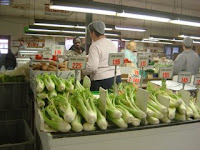I was guided in my culinary questions by Nigel Slater in his book, Tender: A cook and his vegetable patch. Slater devotes a chapter to the mystery bean. I settled into the rocker on the back deck and eagerly read about stunning flowers (which I missed) and autumn plantings (which I assumed was a UK anomaly). I decided that my beans were past the "cook them in their pods" stage, so I opted for a shelled bean recipe.
I had about a pound of pods. A good pod yielded three beans. But wait ... the uncovering continues. You have to now peel the outer shell off of the bean. Boiling salted water for 5 minutes followed by an ice bath. Now the beans are both tender and easily removed from their jackets. In the end I had about 4 ounces of edible bean. Hmmmm.
But Slater proposed this lovely pairing of the beans in a sherry vinegar vinaigrette on thin slices of Spanish ham. Prosciutto would have to do with a side offering of cheddar and fresh feta it made a perfect lunch.
 So having relied on Slater's Fava Bean chapter, I turned now to the chapter on Celery. You have to love a Table of Contents that reads like a seed catalog. I knew celery was challenging so I was hoping to enjoy special tips on how to have a successful crop. Once again, iced tea in hand, I settled into my outdoor perch and opened to CELERY. Under the heading celery in the garden I read. "I have never grown celery, and what is more I probably never will. Celery is a crop only for the most committed of gardeners."
So having relied on Slater's Fava Bean chapter, I turned now to the chapter on Celery. You have to love a Table of Contents that reads like a seed catalog. I knew celery was challenging so I was hoping to enjoy special tips on how to have a successful crop. Once again, iced tea in hand, I settled into my outdoor perch and opened to CELERY. Under the heading celery in the garden I read. "I have never grown celery, and what is more I probably never will. Celery is a crop only for the most committed of gardeners."I was crestfallen. Not that I have a prayer of getting a crop in THIS year, but I was hoping for some measure of encouragement. I ate fresh celery once. It was at a Farmer's Market in Pennsylvania and the experience was like eating a new vegetable for the first time. It was sweet, crisp and bursting with flavor. I think it was Eleanor Roosevelt who said "You must do the thing you think you cannot do."






